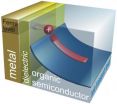(Press-News.org) Organic semiconductors allow for flexible displays (OLEDs), solar cells (OPVCs), and other interesting applications. One common problem in these devices, however, is the interface between the metallic contacts and the organic semiconductor material, where undesirable losses occur. Now Dr. Martin Oehzelt has shown what these losses between the metal and the organic semiconductors depend upon and how to minimize them. In particular, his model also explains why a thin, electrically insulating layer between the two materials can even facilitate the transition of charge carriers. His results have recently been published in Nature Communications.
Currently, there are many different approaches describing the interface between organic semiconductor materials and metallic contacts. These somewhat contradictory theories, none of which is universally valid for all cases, have now been unified by Oehzelt and developed into a single coherent model based on the electrostatic potential caused by the charge carriers in the metal and the organic semiconductor. "I calculated the impact of the charge carrier distribution on the electronic states at the interface and how these changes feed back onto the charge carrier distribution", he explains. Oehzelt is presently conducting research with Dr. Georg Heimel as a postdoc for Prof. Norbert Koch, who works at the Humboldt-Universität zu Berlin and the Helmholtz-Zentrum Berlin.
Such calculations have never been so comprehensively carried out before. Performing them, Oehzelt states: "it was surprising to me that the quantum physical level was not that important. The electrostatic effects predominated! The agreement between our model and the experimental data were astonishing." On the example of pentacene, a common organic semiconductor, Oehzelt has quantitatively checked the model's predictions for interface losses.
The energy distribution of the electronic states in organic semiconductors determines the minimum energy barrier the charge carriers have to overcome in transitioning from or into the metal. The calculation demonstrates that the shape of this energy barrier can vary, from a step-function to slow, continuously rising curves that lead to considerably lower losses. The latter can be achieved by introducing an extremely thin insulating layer between the organic semiconductor and the metal. Contrary to the general expectation, the introduction of an insulator thus improves the electrical contact.
The results of this work could notably simplify optimization of interfaces and contacts and, thereby, the development of more efficient organic electronic devices.
INFORMATION:
The work has recently been published in Nature Communications
doi 10.1038/ncomms5174
Electrostatics do the trick
A simple model describes what happens between organic semiconductors and metals
2014-06-23
ELSE PRESS RELEASES FROM THIS DATE:
New study offers potential avenues for treatment of deadly nasopharyngeal cancer
2014-06-23
A team of scientists from the Cancer Science Institute of Singapore (CSI Singapore) at the National University of Singapore, National University Cancer Institute Singapore (NCIS) and National University Hospital Singapore (NUH), discovered a distinct mutational signature and nine significantly mutated genes associated with nasopharyngeal cancer, paving the way to developing novel therapies for this deadly disease.
The research group, led by Professor H. Phillip Koeffler, Senior Principal Investigator at the CSI Singapore and Deputy Director of NCIS, has conducted the ...
Cell stress inflames the gut
2014-06-23
Over 3.5 million people in Europe and the US suffer from Crohn's disease or ulcerative colitis – the two most common forms of IBD. Chronic bowel inflammation is caused by an overreaction of the immune system to the bacteria which naturally occur in the gut. "This overreaction can come about if, for example, the anti-stress mechanism in the cells of the intestinal mucosa does not function correctly," explains Prof. Dirk Haller of the TUM Chair of Nutrition and Immunology.
What Prof. Haller is referring to is the unfolded protein response (UPR) – a sequential chain of ...
Blood sugar improves with first gastrointestinal microbiome modulator, NM504
2014-06-23
CHICAGO, IL — In adults with prediabetes, a new drug that alters microbial populations and their environment in the gastrointestinal (GI) tract improves glucose tolerance—the body's response to consuming carbohydrates— after four weeks of treatment and without a change in diet. These results, from a pilot study, will be presented Monday at the joint meeting of the International Society of Endocrinology and the Endocrine Society: ICE/ENDO 2014 in Chicago.
The not-yet-named therapeutic, NM504, is the first in a new class of therapies known as GI microbiome modulators. The ...
When couples disagree on stroke recovery, one partner can suffer
2014-06-23
CINCINNATI—An innovative study from a University of Cincinnati (UC) social work researcher has found that when a stroke survivor and his or her caregiving spouse disagree on the survivor's rate of recovery, the caregiving spouse is more likely to experience depression and emotional distress.
Assistant Professor Michael McCarthy, PhD, working with co-author Karen Lyons at the Oregon Health and Science University, interviewed 35 couples in which one spouse had experienced a stroke within the past three years.
In separate sessions, stroke survivors and their spouses discussed ...
Cancer genes hijack enhancers
2014-06-23
Medulloblastoma is the most common childhood brain tumor. It is classified in four distinct subgroups that vary strongly in terns of the aggressiveness of the disease. Group 3 and Group 4 tumors, which are very challenging, are particularly common. "For these two tumor groups, hardly any characteristic genomic changes that drive tumor growth and would make potential targets for drug development have been identified," says Prof. Dr. Peter Lichter from the German Cancer Research Center (Deutsches Krebsforschungszentrum, DKFZ), who is coordinator of the PedBrain Tumor network. ...
Physicists find way to boot up quantum computers 72 times faster than previously possible
2014-06-23
Press the start button, switch on the monitor, grab a cup of coffee and off you go. That is pretty much how most us experience booting up a computer. But with a quantum computer the situation is very different. So far, researchers have had to spend hours making dozens of adjustments and fine calibrations in order to set up a chip with just five quantum bits so that it can be used for experimental work. (One quantum bit or 'qubit' is the quantum physical equivalent of a single bit in a conventional computer). Any small errors in the adjustment and calibration procedure and ...
The first demonstration of a self-powered cardiac pacemaker
2014-06-23
Daejeon, Republic of Korea, June 23, 2014--As the number of pacemakers implanted each year reaches into the millions worldwide, improving the lifespan of pacemaker batteries has been of great concern for developers and manufacturers. Currently, pacemaker batteries last seven years on average, requiring frequent replacements, which may pose patients to a potential risk involved in medical procedures.
A research team from the Korea Advanced Institute of Science and Technology (KAIST), headed by Professor Keon Jae Lee of the Department of Materials Science and Engineering ...
Have you been unlucky -- or are you just lazy?
2014-06-23
A new study from the interdisciplinary Interacting Minds Centre at Aarhus University examines the difference between American and Danish attitudes to welfare services. Even though the two countries are traditionally portrayed as being miles apart in this respect, the study concludes that the difference between the ways the two societies are organised is not due to fundamental differences in attitude about when the state should provide financial assistance for citizens.
"The study challenges the conventional wisdom that we Danes are more inclined to play the Good Samaritan ...
New research proves gender bias extraordinarily prevalent in STEM careers
2014-06-23
NEW YORK — With everyone from the federal government to corporate America working to encourage more women to pursue careers in science, technology, engineering and math (STEM) fields, you would think the doors would be wide open to women of all backgrounds. A new study from Columbia Business School shows that this could not be further from the truth and that gender bias among hiring managers in STEM fields is extraordinarily prevalent.
"How Stereotypes Impair Women's Careers in Science," written by Ernesto Reuben, assistant professor of management at Columbia Business ...
We can eliminate the major tornado threat in Tornado Alley
2014-06-23
The annually recurring devastating tornado attacks in US Tornado Alley raise an important question: Can we eliminate the major tornado threat in Tornado Alley? Some people may claim that such a question is beyond imagination as people are powerless in facing violent tornadoes. However, according to Professor Rongjia Tao's recent publication in IJMPB, human beings are not powerless on this issue: if we build three east-west great walls in Tornado Alley, we will eliminate major tornado threat there forever. These walls can be built locally at high tornado risk areas to eliminate ...
LAST 30 PRESS RELEASES:
Tracing the quick synthesis of an industrially important catalyst
New software sheds light on cancer’s hidden genetic networks
UT Health San Antonio awarded $3 million in CPRIT grants to bolster cancer research and prevention efforts in South Texas
Third symposium spotlights global challenge of new contaminants in China’s fight against pollution
From straw to soil harmony: International team reveals how biochar supercharges carbon-smart farming
Myeloma: How AI is redrawing the map of cancer care
Manhattan E. Charurat, Ph.D., MHS invested as the Homer and Martha Gudelsky Distinguished Professor in Medicine at the University of Maryland School of Medicine
Insilico Medicine’s Pharma.AI Q4 Winter Launch Recap: Revolutionizing drug discovery with cutting-edge AI innovations, accelerating the path to pharmaceutical superintelligence
Nanoplastics have diet-dependent impacts on digestive system health
Brain neuron death occurs throughout life and increases with age, a natural human protein drug may halt neuron death in Alzheimer’s disease
SPIE and CLP announce the recipients of the 2025 Advanced Photonics Young Innovator Award
Lessons from the Caldor Fire’s Christmas Valley ‘Miracle’
Ant societies rose by trading individual protection for collective power
Research reveals how ancient viral DNA shapes early embryonic development
A molecular gatekeeper that controls protein synthesis
New ‘cloaking device’ concept to shield sensitive tech from magnetic fields
Researchers show impact of mountain building and climate change on alpine biodiversity
Study models the transition from Neanderthals to modern humans in Europe
University of Phoenix College of Doctoral Studies releases white paper on AI-driven skilling to reduce burnout and restore worker autonomy
AIs fail at the game of visual “telephone”
The levers for a sustainable food system
Potential changes in US homelessness by ending federal support for housing first programs
Vulnerability of large language models to prompt injection when providing medical advice
Researchers develop new system for high-energy-density, long-life, multi-electron transfer bromine-based flow batteries
Ending federal support for housing first programs could increase U.S. homelessness by 5% in one year, new JAMA study finds
New research uncovers molecular ‘safety switch’ shielding cancers from immune attack
Bacteria resisting viral infection can still sink carbon to ocean floor
Younger biological age may increase depression risk in older women during COVID-19
Bharat Innovates 2026 National Basecamp Showcases India’s Most Promising Deep-Tech Ventures
Here’s what determines whether your income level rises or falls
[Press-News.org] Electrostatics do the trickA simple model describes what happens between organic semiconductors and metals



